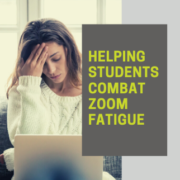Sensory Processing: In the Classroom
Sensory Processing Disorder (SPD) is a complex condition for several different reasons. Because the symptoms range in severity and can be vastly different from child to child, SPD is often misunderstood by peers, parents, and educators. Furthermore, the symptoms for toddlers, preschool-aged, and school-aged children are also rather common for the age group, causing them to be overlooked or ignored. For instance, school-aged children with SPD may be fidgety, worrisome, aggressive, withdrawn, easily distracted, sensitive, etc. These symptoms resemble the typical behavior of any 7-12 year old from time to time. In fact, these same characteristics could apply to the average adult on any given day.
As discreet as this condition can be, SPD can have significant effects on a child’s ability to learn and adapt to different environments. This, of course, could result in setbacks in the classroom, both socially and academically. Again, because of the varying degrees of severity, symptoms of SPD can be camouflaged by our understanding of the characteristics of certain age groups. Here are some fast facts about SPD and its potential effects on students.
- SPD is a condition that affects the brain’s ability to receive, interpret, and respond to information that comes through the senses. This means that students may have difficulty with sights, sounds, textures, and agility/movement.
- Sensory Processing Disorder can cause oversensitivity of the senses. For instance, a child may be particularly bothered by the tactile feel of a certain type of material or fabric. Others with SPD could be easily disturbed by common sounds or certain levels of light. Furthermore, students may experience a combination of sensory sensitivity, meaning that more than one sense can adversely affect their ability to receive and retain information.
- These aversions to certain sensory messages may seem arbitrary or overly dramatic to people that are unfamiliar with this condition. However, a child with SPD is truly affected by these triggers. A certain ordinary sound or texture of a specific food could cause a child to become physically sick. Obviously, these aversions and reactions can greatly affect the child’s social and cognitive development.
- Because of misinformation or complete ignorance of the condition, a student’s peers may be highly confused by the student’s reaction to sensory stimuli. Not only can the behaviors create difficulty for students with SPD, but the social aspect makes cooperative learning and group work an additional difficulty.
- Some children with SPD struggle more with spatial awareness. This means that they may exhibit a lack of coordination, difficulty with physical play or movement, and may frequently bump into things while walking. Children that fall on this end of the spectrum of SPD will also exhibit clumsiness and an inability to control or manage their limbs in relation to their surroundings. Therefore, physical education classes, sports, and other extracurricular activities could be difficult or intimidating for students that struggle with physiological symptoms of SPD.
- Because SPD is not currently categorized as a medical condition, treatment options can be difficult to come by. For most occupational therapists treating children with sensory processing problems, a common approach is called “sensory integration.” Similarly to exposure therapy, sensory integration involves presenting the child with opportunities to confront the sounds, sights, tastes, textures, etc., that cause discomfort or distress. The idea behind this method is to strategically teach the child how to interpret and respond appropriately to the sensory input.
- Some forms of physical therapy could also be beneficial when movement and physical functions are compromised by SPD. Again, the idea is to exercise the brain like a muscle, acclimating it to receive and respond properly.
- Sensory Processing Disorder does not necessarily have to accompany another condition; however, it is commonly seen in children on the autism spectrum.







